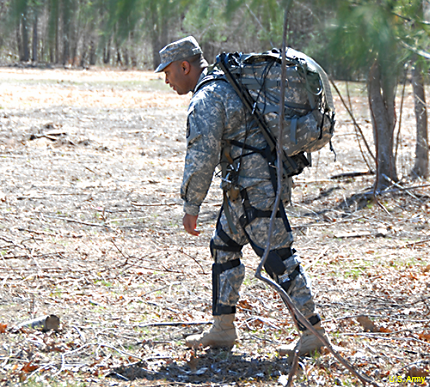Harvest time: Wearable gear generates its own power
The Army is testing technologies that could take batteries out of the equation for soldiers in the field.

A soldier conducts maneuvers with an energy-harvesting backpack, knee harvester and flexible solar panels at MFIX.
The amount of power-hogging gear a soldier carries into the field is constantly growing—networked radios, mobile devices, sensors, and optical and targeting devices all run on electricity. That means they also have to carry more batteries, particularly on long-duration missions, which only adds to the weight they have to carry.
Soon, however, they could be “carrying”—that is, wearing—devices that will generate the power they need and lighten the load in the process.
Researchers at the Natick Soldier Research, Development and Engineering Center have been developing and testing wearable technologies that generate power, including solar panels, and backpack and knee kinetic energy harvesting devices. Prototypes of the technologies were tested in September at the Maneuver Fires Integration Experiment, or MFIX, at Fort Benning, Ga., according to an Army release.
“My initial impression is that they fulfill a need for instant power generation on long-range missions when displaced from traditional resupply methods,” said one of the demonstration’s participants, Sgt. 1st Class Arthur H. Jones of the Maneuver Center of Excellence.
The weight loss would be pretty significant. According to a 2013 report in the Maneuver Center’s Infantry Online, a dismounted infantryman in Afghanistan carried about 9.7 pounds of batteries. That weight would increase to 14 pounds for a 72-hour mission if all soldiers were brought into the network (something the Army is doing). And a big chunk of that weight comes in the form of extra batteries—on a 72-hour mission, a soldier without the means to recharge would have to swap out batteries at least seven times.
Having gear that generates its own power could not only eliminate the weight but get the Army closer to a “net zero” energy-use soldier—that is, one who generates as much power as he or she uses. (The Army is taking a similar net-zero approach to its bases.)
The devices tested at MFIX include:
Lightning Pack’s Rucksack Harvester, which uses a miniature power generator and the movement of the backpack to drawn kinetic energy as a soldier walks or runs. It can generate 16 to 22 watts while walking, and 22 to 40 watts while running.
Bionic Power’s Knee Harvester, which is attached to the upper and lower parts of each leg and collects kinetic energy when the knees are flexed during walking or running.
MC-10’s photovoltaic, or PV, Solar Panel Harvester, which covers the backpack and helmet with a thin, flexible layer of gallium arsenide crystals. Under optimum conditions—facing the sun on a clear day—the backpack panel can generate 10 watts; the helmet, 7 watts.
Natick researchers said they’re also exploring other energy harvesting technologies that could be used effectively in the field. As for the devices tested at MFIX, researchers, having collected power management data and user feedback, will next work to sync the devices to the Integrated Soldier Power Data System, which distributes power to the devices a soldier carries.



